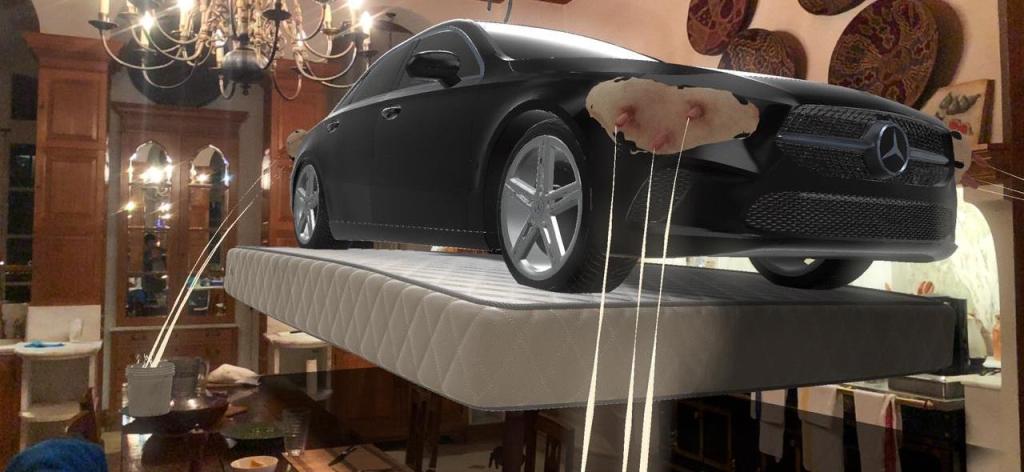[ad_1]
About a year after it was supposed to debut at the 58th Venice Biennale, artist Darren Bader’s augmented reality app is finally in private beta testing.
When the Biennale ended its six-month run in November, the website for the program, whose title is Mendes Mundi, still stated, “Is this an art prank? Not at all. The app is just delayed.”
The original programming team “wasn’t able to deliver and strung us along for way too long,” said Bader. “We ran out of time. So six weeks pre-Biennale, we began to scramble; scramble caused further financial drain.” Development continued, with additional troubles, as the months passed. On one of Bader’s Instagrams he put it starkly: “I nearly bankrupted myself with this.”
Augmented reality has recently becoming a tool for artists like Martine Syms, Pierre Huyghe, and KAWS, who just released an AR version of one of his “Companion” figures. Firing up Bader’s app, you can pick from 13 AR characters that he conceived with animator Rodrigo Pires. After a couple taps, they inhabit the world as seen through your camera (only on iPhone at the moment). There’s a gorilla wearing cowboy boots who DJs on a pair of turntables; two humans whose faces are filled with charging outlets (one with a hooved leg, among other abnormalities); beautiful blue butterfly wings that carry a walnut and—no way to put it politely—a scrotum; and a sizable fish, strapped with dynamite sticks, that flops about.
These fantastical creatures are not out of step with Bader’s real-life sculptures, which often involve combinations of two or three disparate objects or people, and have self-explanatory titles like persian rug and/with tripod and/with sous chef, oysters and/with peanut butter, and lasagna on heroin.

Andrew Russeth
Bader, who is 42 and lives in New York, said AR first piqued his interest during a conversation with a filmmaker friend, Tommaso Bertani, in Rome in 2018. “Once I was reminded of how Venice functioned—the great, ornate, pedestrian labyrinth—there was some sort of subconscious dovetail,” he said. He sees AR as “an optimal merger of cinema and sculpture.”
As for the digital creatures he has conjured, “I just let my mind wander and would sometimes sketch as well as a second-grader might,” Bader said. A Photoshop artist made mockups from those drawings, and then Pires weighed in. “It’s strange, I was thinking how dense I can be when a consumer of satire, and yet these characters are often satirical in nature,” he said.
Suggesting send-ups of video-game tropes or out-of-left-field internet memes, some of the figures were directly inspired by the Floating City. “The human charging stations were conceived in dialog with Venetian tourism and the giant cross-wielder was in dialog with the ubiquitous Catholicism,” Bader said.
The latter is a woman who appears to be 30 feet tall; her huge crucifix sports a tennis ball at its bottom for padding, and she’s walking a dog. She filled most of an empty Brooklyn street the other day, ambling slowly between parked cars and looking disturbingly lifelike. “She’s great on a basketball court as well,” Bader said. (Some of the apparitions require a fair amount of space to spawn, so the recent stay-at-home directives have been an unlikely boon for using the app.)
Despite increased interest in the genre of late, augmented-reality art is in its infancy. For her 2017 Museum of Modern Art exhibition, Syms created a charming app that brought certain artworks to life, and Huyghe’s Skulptur Projekte Münster blowout that year included a fittingly obscure AR element. KAWS’s effort includes a Companion who will float lifelessly, hands over its eyes, any place you choose. (That piece is free until April 15; others can be rented for $6.99 a week.)
As for Mendes Mundi, Bader is still aiming to see it through to completion, even if it’s scaled back a bit and reworked from his initial conception—“no GPS, no treasure hunt, which I’m growing to embrace,” he said.
The app also originally had an elaborate backstory about the uncanny digital forms being the work of one Scott Mendes, an itinerant artist whose surreal visions are inspired by dreams he has after injecting himself with pigeon guano. Mendes’s identity “is increasingly less germane to the project,” Bader explained. “That being said it’s too tough to kick the pigeon shit prophet to the curb.”
As Bader proceeds, there are practical matters to address: more characters to complete, and technical issues like shadows to hone. “We’re looking for institutional support to help fund the final phase of coding,” Bader said. He imagines the end result may be three different apps, each with various cast members, and he’d like to get it on Android. “But the sooner the better!” he said. “I want people to have fun!”
[ad_2]
Source link

